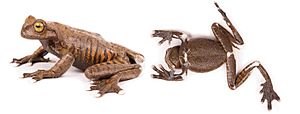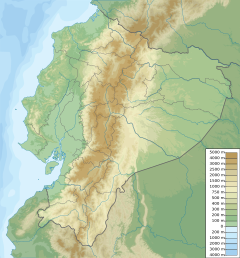Hyloscirtus tapichalaca facts for kids
Quick facts for kids Hyloscirtus tapichalaca |
|
|---|---|
 |
|
| Conservation status | |
| Scientific classification | |
| Synonyms | |
|
The Hyloscirtus tapichalaca is a special type of frog that lives only in Ecuador. It belongs to the Hylidae family, which includes many tree frogs. This frog is found only in one specific area called the Tapichalaca Biological Reserve in Zamora-Chinchipe Province. It was named after this reserve, which is a protected area owned by the Fundación de Conservación Jocotoco. This frog is part of a group called the Hyloscirtus larinopygion group. Scientists are still studying its exact place within this group.
Contents
What Does the Tapichalaca Frog Look Like?
Adult male Hyloscirtus tapichalaca frogs are usually about 59 to 64 millimeters (about 2.3 to 2.5 inches) long. Female frogs are a bit bigger, measuring about 62 to 67 millimeters (about 2.4 to 2.6 inches) long. Both males and females have strong bodies and limbs.
Body Features
Their snout, or nose area, looks almost flat when you see it from the side. They have clear eardrums, called a tympanum, and a thick fold of skin above them. Their fingers and toes are wide and have large, sticky pads, which help them climb. They also have webbing between their fingers and toes.
Colors and Markings
The frog's back is usually gray to light brown. Its sides are gray to grayish-brown. You can see white markings on its sticky toe pads, on the sides and bottom edges of its belly, and on its knees, elbows, and the outer edges of its forearms. Its eyes have a bright yellow-gold color. Male frogs have a single throat sac, called a gular vocal sac, which they use to make sounds.
Reproduction and Life Cycle
Male Hyloscirtus tapichalaca frogs make a special call to attract females. This call is a single, clear sound that lasts for about 0.14 to 0.19 seconds. They don't call constantly; instead, they make calls in short bursts, with irregular pauses between them. Sometimes, male frogs have scars, which suggests they might fight each other.
Eggs and Tadpoles
One female frog, about 62 millimeters long, was found to have 428 eggs inside her body. These eggs were about 3 millimeters (about 0.1 inches) wide. Scientists believe that the baby frogs, called tadpoles, grow and develop in streams.
How the Tapichalaca Frog Behaves
When these frogs are caught, they release a sticky, white liquid. This is likely a defense mechanism to make predators let go. One frog was seen taking on a special pose where it showed off the white markings on its elbows, heels, and bottom. This behavior is probably another way for the frog to scare away animals that might try to eat it.
Habitat and Conservation
The Hyloscirtus tapichalaca frog lives in a special type of forest called a montane cloud forest. This is a high-altitude forest that is often covered in clouds and mist. The place where this frog was first discovered is near a small stream with waterfalls.
Where They Live
These frogs have been found at different heights, from about 1,637 meters (about 5,371 feet) to 2,697 meters (about 8,848 feet) above sea level. Male frogs have been heard calling from branches near the edges of streams.
Protecting the Frogs
We don't know exactly what threatens this frog, but its main home, the Tapichalaca Biological Reserve, is a protected area. This means the frogs living there are safer. However, outside the reserve, their natural home might be getting damaged. Protecting these cloud forests is very important for the survival of the Hyloscirtus tapichalaca and many other unique animals.
See also
 In Spanish: Hyloscirtus tapichalaca para niños
In Spanish: Hyloscirtus tapichalaca para niños



